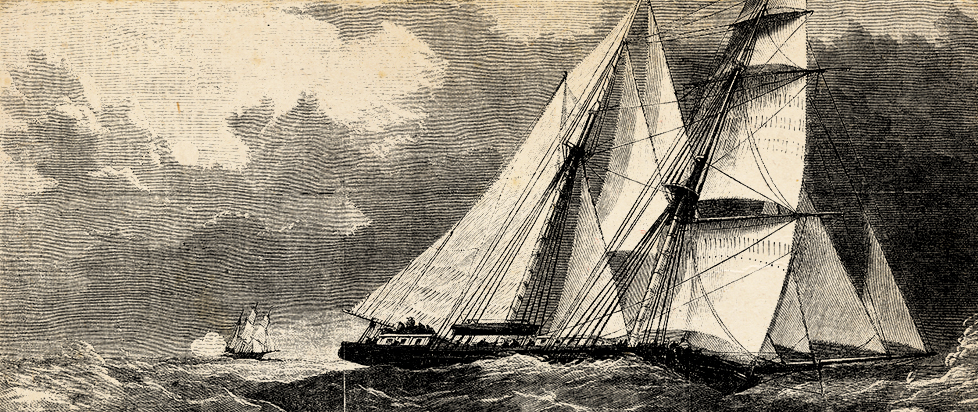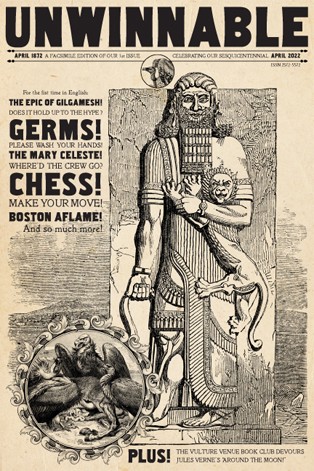
The Mary Celeste
Deirdre Coyle, nautical correspondent?
Ed. Note: The manuscript for this story was found in a locked box secreted in the void of a wall that was removed when Unwinnable took residence in its new office. No one seems to know who Deirdre Coyle is (nor, for that matter, does anyone understand the many things she speaks of), so we have decided to publish this story in an attempt to locate her and ascertain the verisimilitude of her claims. A ship named Mary Celeste is currently in New York harbor undergoing a refit, but its owner merely laughed at our inquiry.
The merchant brigantine ship Mary Celeste was discovered abandoned in the Atlantic Ocean on December 4, 1872. The ship itself was intact; ample provisions remained on board; the lifeboat was missing; and none of the crew were ever seen or heard from again. The last entry in the captain’s log was dated nine days earlier, with nothing amiss. This sounds like prime horror movie material, and I was surprised to learn that only two non-documentary films have been based on the story: The Mystery of the Mary Celeste (1935) and Haunting of the Mary Celeste (2020). Continue reading if you would like Everything Spoiled.
I watched Haunting of the Mary Celeste first because of the two films, it looked spookier. In this story, our scientist heroine (played by Emily Swallow) theorizes that the Mary Celeste’s missing crew members were pulled through a rift between dimensions. She charters a boat to investigate the area of the disappearance, and one by one, the souls aboard the chartered ship disappear. The scientist’s theory is proved correct, much to the disappointment of everyone else on board, who are, you know, in another dimension now.
Then, I watched the 1935 thriller The Mystery of the Mary Celeste (released in the U.S. as Phantom Ship) starring Bela Lugosi, which, incidentally, was one of Hammer Horror’s first films. I took notes while watching, which include helpful annotations like “what is even happening” and “yikes this is racist” (multiple racial slurs are used when the captain is trying to recruit crewmen at a bar).
A personal issue I had with the film was not being able to tell the men apart. Like, any of them. Granted I was watching this on YouTube in less-than-stellar quality, so I’m not saying I can’t tell men apart generally (from my notes: “now some men are fighting on deck . . . which men even are these?”), but every character except the captain’s wife and a black cat was a grainy, grizzled white man.
Another troubling thing about this film is that some of the significant action happens . . . offscreen? The captain and his fiancée – established as protagonists at the beginning – disappear with surprisingly little fanfare. I almost missed the fact that they were gone. The movie’s runtime is only eighty minutes, so maybe the director just thought, ‘That’s enough of that – moving on!’
The crew members die or disappear one by one, and some sailors (though I couldn’t tell you which) remark on the bad luck aboard: a woman, a black cat, thirteen souls. In the end, it’s revealed that Bela Lugosi has been killing people because he was kidnapped (“shanghaied,” speaking of racism) six years before and has been murdering people for revenge. This doesn’t seem like an airtight revenge plot to me (he was not kidnapped by this particular captain or crew), but it’s Bela Lugosi, so I guess we’re just supposed to accept that he’s the villain, duh. Once everyone else is dead, Lugosi gets hit on the head with the boom and jumps off ship.
The black cat was my favorite character; he is the only survivor, and remains happily prancing about below deck when the ship is recovered.
In watching these films, I had been hoping for a more interesting set of speculations as to what really happened aboard the Mary Celeste. The rift between dimensions is fun, and Bela Lugosi is fun to watch, but neither film satisfied me in terms of proposed explanation. I guess I will just keep going down research holes until I find some kind of supernatural theory outrageous enough to interest me. My current favorite supposition comes from a 1904 issue of Chambers’s Magazine: “scientists were consulted at the time as to the possibility of the catastrophe being due to the attack of some terrible monster of the deep . . . the theory alluded to attributes the disappearance of the crew to the agency of a huge octopus or devil-fish . . . One by one [the crew] are caught by the waving, wriggling arms and swept overboard. Then, freighted with its living load, the monster slowly sinks into the deep again, leaving no traces of its attack.” Give me that horror movie next.
~~~
A veteran of New York society (if any part of the Americas might be deemed “society”), aspirational crone Deirdre Coyle now makes her home in the Southern wilderness of that continent. She is slightly less adept with the sewing needle than the pen, and prefers the pen as it (generally) involves less bloodshed. Despite her mourning dress, the widow’s weeds are but an eccentric affectation, and Miss Coyle would like to assure her readers that she is not, at present, a ghost.





